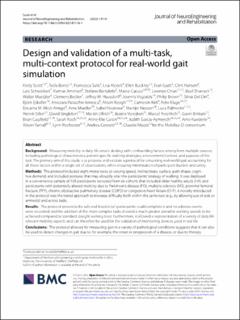| dc.contributor.author | Scott, Kirsty | |
| dc.contributor.author | Bonci, Tecla | |
| dc.contributor.author | Salis, Francesca | |
| dc.contributor.author | Alcock, Lisa | |
| dc.contributor.author | Buckley, Ellen | |
| dc.contributor.author | Gazit, Eran | |
| dc.contributor.author | Hansen, Clint | |
| dc.contributor.author | Schwickert, Lars | |
| dc.contributor.author | Aminian, Kamiar | |
| dc.contributor.author | Bertuletti, Stefano | |
| dc.contributor.author | Caruso, Marco | |
| dc.contributor.author | Chiari, Lorenzo | |
| dc.contributor.author | Sharrack, Basil | |
| dc.contributor.author | Maetzler, Walter | |
| dc.contributor.author | Becker, Clemens | |
| dc.contributor.author | Hausdorff, Jeffrey M. | |
| dc.contributor.author | Vogiatzis, Ioannis | |
| dc.contributor.author | Brown, Philip | |
| dc.contributor.author | Del Din, Silvia | |
| dc.contributor.author | Eskofier, Björn | |
| dc.contributor.author | Paraschiv-Ionescu, Anisoara | |
| dc.contributor.author | Keogh, Alison | |
| dc.contributor.author | Kirk, Cameron | |
| dc.contributor.author | Kluge, Felix | |
| dc.contributor.author | Micó-Amigo, Encarna M. | |
| dc.contributor.author | Mueller, Arne | |
| dc.contributor.author | Neatrour, Isabel | |
| dc.contributor.author | Niessen, Martijn | |
| dc.contributor.author | Palmerini, Luca | |
| dc.contributor.author | Sillen, Henrik | |
| dc.contributor.author | Singleton, David | |
| dc.contributor.author | Ullrich, Martin | |
| dc.contributor.author | Vereijken, Beatrix | |
| dc.contributor.author | Froehlich, Marcel | |
| dc.contributor.author | Brittain, Gavin | |
| dc.contributor.author | Caulfield, Brian | |
| dc.contributor.author | Koch, Sarah | |
| dc.contributor.author | Carsin, Anne-Elie | |
| dc.contributor.author | Garcia-Aymerich, Judith | |
| dc.contributor.author | Kuederle, Arne | |
| dc.contributor.author | Yarnall, Alison | |
| dc.contributor.author | Rochester, Lynn | |
| dc.contributor.author | Cereatti, Andrea | |
| dc.contributor.author | Mazzà, Claudia | |
| dc.date.accessioned | 2023-02-09T10:12:31Z | |
| dc.date.available | 2023-02-09T10:12:31Z | |
| dc.date.created | 2023-01-03T08:52:13Z | |
| dc.date.issued | 2022 | |
| dc.identifier.citation | Journal of NeuroEngineering and Rehabilitation. 2022, 19 (1), . | en_US |
| dc.identifier.issn | 1743-0003 | |
| dc.identifier.uri | https://hdl.handle.net/11250/3049584 | |
| dc.description.abstract | Background
Measuring mobility in daily life entails dealing with confounding factors arising from multiple sources, including pathological characteristics, patient specific walking strategies, environment/context, and purpose of the task. The primary aim of this study is to propose and validate a protocol for simulating real-world gait accounting for all these factors within a single set of observations, while ensuring minimisation of participant burden and safety.
Methods
The protocol included eight motor tasks at varying speed, incline/steps, surface, path shape, cognitive demand, and included postures that may abruptly alter the participants’ strategy of walking. It was deployed in a convenience sample of 108 participants recruited from six cohorts that included older healthy adults (HA) and participants with potentially altered mobility due to Parkinson’s disease (PD), multiple sclerosis (MS), proximal femoral fracture (PFF), chronic obstructive pulmonary disease (COPD) or congestive heart failure (CHF). A novelty introduced in the protocol was the tiered approach to increase difficulty both within the same task (e.g., by allowing use of aids or armrests) and across tasks.
Results
The protocol proved to be safe and feasible (all participants could complete it and no adverse events were recorded) and the addition of the more complex tasks allowed a much greater spread in walking speeds to be achieved compared to standard straight walking trials. Furthermore, it allowed a representation of a variety of daily life relevant mobility aspects and can therefore be used for the validation of monitoring devices used in real life.
Conclusions
The protocol allowed for measuring gait in a variety of pathological conditions suggests that it can also be used to detect changes in gait due to, for example, the onset or progression of a disease, or due to therapy. | en_US |
| dc.language.iso | eng | en_US |
| dc.publisher | BioMed Central | en_US |
| dc.rights | Navngivelse 4.0 Internasjonal | * |
| dc.rights.uri | http://creativecommons.org/licenses/by/4.0/deed.no | * |
| dc.title | Design and validation of a multi-task, multi-context protocol for real-world gait simulation | en_US |
| dc.title.alternative | Design and validation of a multi-task, multi-context protocol for real-world gait simulation | en_US |
| dc.type | Peer reviewed | en_US |
| dc.type | Journal article | en_US |
| dc.description.version | publishedVersion | en_US |
| dc.source.pagenumber | 0 | en_US |
| dc.source.volume | 19 | en_US |
| dc.source.journal | Journal of NeuroEngineering and Rehabilitation | en_US |
| dc.source.issue | 1 | en_US |
| dc.identifier.doi | 10.1186/s12984-022-01116-1 | |
| dc.identifier.cristin | 2099270 | |
| cristin.ispublished | true | |
| cristin.fulltext | original | |
| cristin.qualitycode | 1 | |

